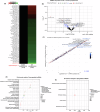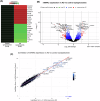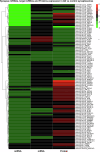Integrated multi-omics analyses of synaptosomes revealed synapse-associated novel targets in Alzheimer's disease
- PMID: 40581657
- PMCID: PMC12532717
- DOI: 10.1038/s41380-025-03095-w
Integrated multi-omics analyses of synaptosomes revealed synapse-associated novel targets in Alzheimer's disease
Abstract
Synapse dysfunction is an early event in Alzheimer's disease (AD) caused by various factors, including amyloid beta, p-tau, inflammation, and aging. However, the precise molecular mechanism underlying synapse dysfunction in AD remains largely unknown. To understand this, we comprehensively analyzed the synaptosomes fraction in post-mortem brain samples from AD patients and cognitively normal individuals. We conducted high-throughput transcriptomic analyses to identify changes in microRNA (miRNA) and mRNA levels in synaptosomes extracted from the brains of unaffected individuals and those with AD. Additionally, we performed mass spectrometry analysis of synaptosomal proteins in the same sample group. These analyses revealed significant differences in the levels of miRNAs, mRNAs, and proteins between the two groups. To gain further insights into the pathways or molecules involved, we employed an integrated omics approach to study the molecular interactions of deregulated synapse miRNAs, mRNAs, and proteins in samples from individuals with AD and the control group, demonstrating the impact of deregulated miRNAs on their target mRNAs and proteins. Furthermore, the DIABLO analysis revealed complex relationships among mRNAs, miRNAs, and proteins that could be key in understanding the pathophysiology of AD. Our study identified novel synapse-associated candidates that could be critical in restoring synapse dysfunction in AD.
© 2025. The Author(s).
Conflict of interest statement
Competing interests: The authors declare no competing interests. Ethics approval and consent to participate: For AD and control human brain tissues, written informed consent for post-mortem brain donation was obtained from the families of donors through the NIH NeuroBioBank. Prior to their transfer to the TTUHSC El Paso, all samples were de-identified, thereby exempting them from the oversight of the Institutional Review Board (IRB).
Figures







Update of
-
Integrated Multi-Omics Analyses of Synaptosomes Revealed Synapse-Centered Novel Targets in Alzheimer's Disease.bioRxiv [Preprint]. 2025 Jan 13:2025.01.09.631584. doi: 10.1101/2025.01.09.631584. bioRxiv. 2025. Update in: Mol Psychiatry. 2025 Nov;30(11):5121-5136. doi: 10.1038/s41380-025-03095-w. PMID: 39868328 Free PMC article. Updated. Preprint.
References
MeSH terms
Substances
Grants and funding
- R00 AG065645/AG/NIA NIH HHS/United States
- R16 GM149497/GM/NIGMS NIH HHS/United States
- GM149497/U.S. Department of Health & Human Services | NIH | National Institute of General Medical Sciences (NIGMS)
- R00AG065645/U.S. Department of Health & Human Services | NIH | National Institute on Aging (U.S. National Institute on Aging)
LinkOut - more resources
Full Text Sources
Medical

